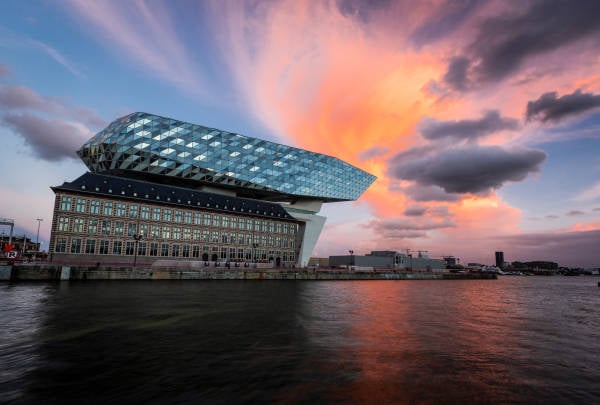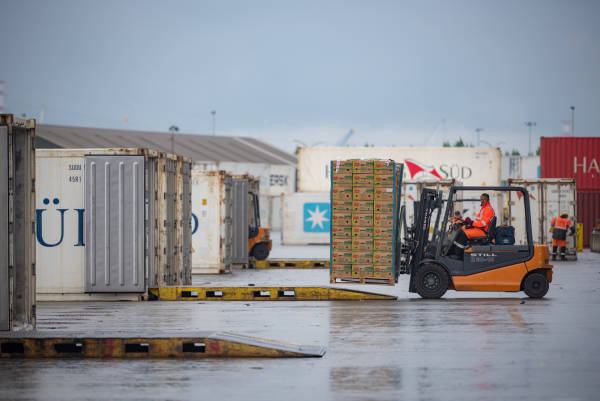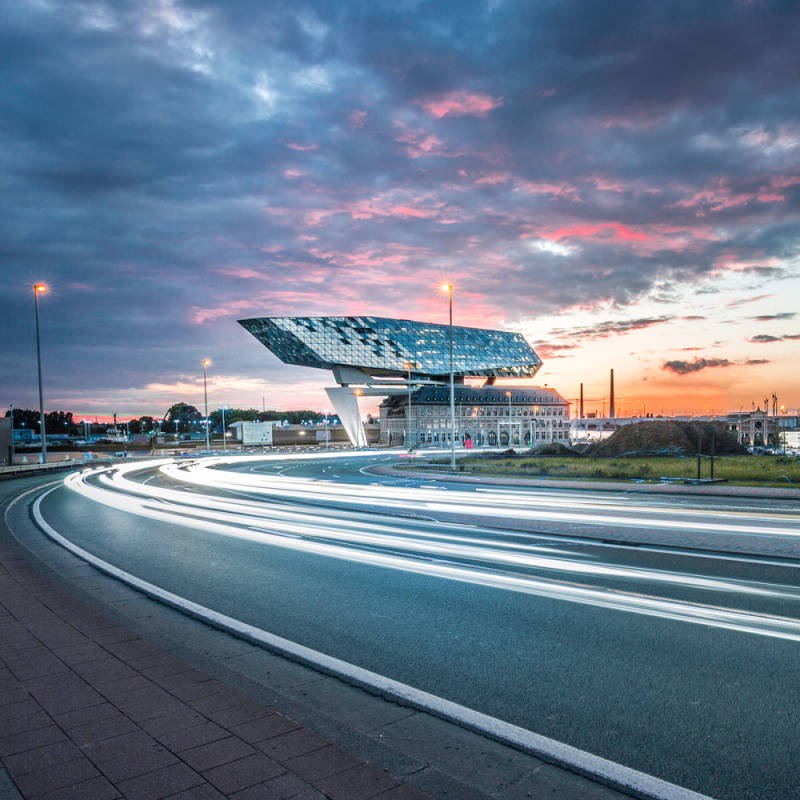
INTEGRATING THE COLLECTIVE
Antwerp wanted to address the missing links in the existing collective transport initiatives in the port and roll out a port-wide approach to collective commuter transport by establishing an integrated and consistent collective transport scheme for the entire port area (as requested by the Flemish Minister of Mobility).
Because of the lack of other transport options in the port area, currently jobseekers without a car are often faced with a barrier they cannot overcome. Before the CIVITAS PORTIS project, the Pendelbus was serving as an open collective transport system (started in 2009 on the Left Bank).
Besides the Pendelbus, there exist other private collective transport systems. The difference is that the Pendelbus stops at easy-accessible locations (P&R, train stations, etc) to pick up employees and then drops them off at their company, whereas the private systems serve a wide range of stops and lines.
In the beginning of the CIVITAS PORTIS project, the idea was to expand the network of the Pendelbus and to encourage companies to increase the number of users. This scope changed during the project to the integration of the existing private collective transport systems.
FACTSHEET 03
TRANSPORT NETWORK
Results, findings & lessons learned
More info
|
|
Context & challenges
CONTEXT & CHALLENGES
The specific objectives of this measure are:
- To expand the collective transport system in the port area to include the companies that have no access to collective transport
- To increase the number of port area commuters making use of collective transport
- To align public and collective transport in the area between city and port.
The measure is implemented in the following stages:
Stage 1:
- Analysis was carried out mapping all existing collective transport lines and the overlap between existing lines and frequency
- A dialogue was set up with the existing schemes: private collective transport systems to check co-operation options
Stage 2:
- Feasibility study on potential of the collective transport, price and the organisational structure
Stage 3:
- Merge of the collective transport schemes for the companies which already use collective transport.
- Continuation of the Pendelbus with optional expanding to the right banks based on demand.
Implementation measures are partly postponed due to the COVID crisis.
- Challenge 1 – Collective transport is much needed in the port area because of the lack of other public transport possibilities. As a result several companies have organized their own collective transport. Therefore it is difficult to integrate these services as employees are used to a rather personalized service.
- Challenge 2 – In addition to the different collective transport offers from private companies, cycling is gaining popularity in the port, too, thanks to e.g. awareness raising campaigns and better cycling infrastructure.
& LESSONS LEARNED


No.
1
The offer has not yet been extended to the right bank.
To expand the collective transport system in the port area to include the companies on the right bank. Same target as above.
2
2
Rating
Comment
Objective and target
To promote the collective transport in the port area as a smart transport mode to commute to the port area: this measure contributes to the target of 10 000 people avoiding the peak hours in the inner city of Antwerp this measure contributes to the target of 18 000 people avoiding the peak hours on the Ring highway around Antwerp
The promotion of the (existing) collective transport offer has been done via the port and through Smart Ways to Antwerp.
Number of collective transport users has been steadily on the increase and especially the Pendelbus users have increased enormously (2015: 41874 users and 2019: 98716 users). On the other hand the users of private initiatives remained stable or decreased slightly.
To increase the number of port area commuters making use of collective transport. Same target as above.
3
The focus of the measure shifted towards this alignment and is worked out in a conceptual plan.
To align public and collective transport in the area between city and port. Same target as above.
4
NA = Not Assessed O = Not Achieved = Substantially achieved (at least 50%) = Achieved in full = Exceeded

INTEGRATING THE COLLECTIVE
TRANSPORT NETWORK
Antwerp wanted to address the missing links in the existing collective transport initiatives in the port and roll out a port-wide approach to collective commuter transport by establishing an integrated and consistent collective transport scheme for the entire port area (as requested by the Flemish Minister of Mobility).
Because of the lack of other transport options in the port area, currently jobseekers without a car are often faced with a barrier they cannot overcome. Before the CIVITAS PORTIS project, the Pendelbus was serving as an open collective transport system (started in 2009 on the Left Bank).
Besides the Pendelbus, there exist other private collective transport systems. The difference is that the Pendelbus stops at easy-accessible locations (P&R, train stations, etc) to pick up employees and then drops them off at their company, whereas the private systems serve a wide range of stops and lines.
In the beginning of the CIVITAS PORTIS project, the idea was to expand the network of the Pendelbus and to encourage companies to increase the number of users. This scope changed during the project to the integration of the existing private collective transport systems.
FACTSHEET 03
Results, findings & lessons learned
More info
Context & challenges
CONTEXT & CHALLENGES
The specific objectives of this measure are:
- To expand the collective transport system in the port area to include the companies that have no access to collective transport
- To increase the number of port area commuters making use of collective transport
- To align public and collective transport in the area between city and port.
The measure is implemented in the following stages:
Stage 1:
- Analysis was carried out mapping all existing collective transport lines and the overlap between existing lines and frequency
- A dialogue was set up with the existing schemes: private collective transport systems to check co-operation options
Stage 2:
- Feasibility study on potential of the collective transport, price and the organisational structure
Stage 3:
- Merge of the collective transport schemes for the companies which already use collective transport.
- Continuation of the Pendelbus with optional expanding to the right banks based on demand.
Implementation measures are partly postponed due to the COVID crisis.
- Challenge 1 – Collective transport is much needed in the port area because of the lack of other public transport possibilities. As a result several companies have organized their own collective transport. Therefore it is difficult to integrate these services as employees are used to a rather personalized service.
- Challenge 2 – In addition to the different collective transport offers from private companies, cycling is gaining popularity in the port, too, thanks to e.g. awareness raising campaigns and better cycling infrastructure.
& LESSONS LEARNED
To promote the collective transport in the port area as a smart transport mode to commute to the port area: this measure contributes to the target of 10 000 people avoiding the peak hours in the inner city of Antwerp this measure contributes to the target of 18 000 people avoiding the peak hours on the Ring highway around Antwerp
No.
1
Objective and target
Rating
Comment
The promotion of the (existing) collective transport offer has been done via the port and through Smart Ways to Antwerp.
No.2 Objective and target
Rating
Comment
To expand the collective transport system in the port area to include the companies on the right bank. Same target as above.
The offer has not yet been extended to the right bank.
No.3 Objective and target
Rating
Comment
Number of collective transport users has been steadily on the increase and especially the Pendelbus users have increased enormously (2015: 41874 users and 2019: 98716 users). On the other hand the users of private initiatives remained stable or decreased slightly.
To increase the number of port area commuters making use of collective transport. Same target as above.
No.4 Objective and target
Rating
Comment
To align public and collective transport in the area between city and port. Same target as above.
The focus of the measure shifted towards this alignment and is worked out in a conceptual plan.
NA = Not Assessed O = Not Achieved = Substantially achieved (at least 50%) = Achieved in full = Exceeded

